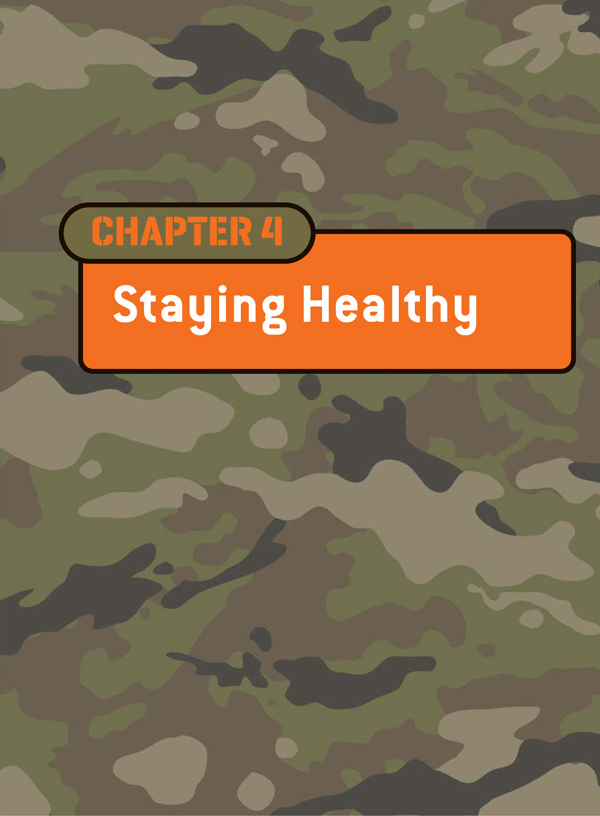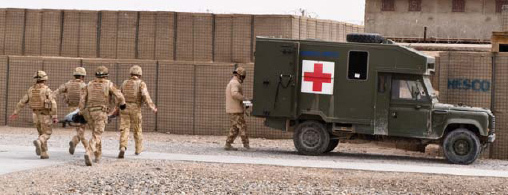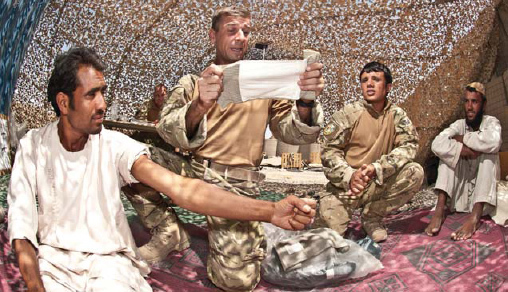
Your health is another of those things you don’t think about until it goes wrong. Especially when you are young and fit. It’s pretty obvious that if you have a leg injury and can’t walk then you can’t soldier. If you have an arm or hand injury you can’t hold a rifle either. What is not so obvious is that an illness, such as where you have to run to the latrine every ten minutes, also takes away from the alert frame of mind which makes you a useful soldier. Your priority then, to stay alive and be at least some use to your mates, is to stay as fit and healthy as possible, given the conditions, so you can keep your mind on your job. Here we will take a look at what you can do to achieve this.
MILITARY FIRST AID/TRIAGE
You can stub your toe or cut yourself shaving just as well when you are soldiering as a civilian can back home. The difference in your job is that on top of all the usual bugs, bumps and bruises you might collect as a civvy, you are also going to be faced with a range of interesting injuries caused by blast or pieces of metal entering the body.
Most wounded soldiers die in the 15 minutes they are waiting for a chopper with medics aboard. What you are trying to do with your first aid, or triage as our US friends call it, is keep your mate alive until a helicopter comes to take him to a real medic. Most casualties don’t die of being blown to bits or shot through the head – they die of choking on their own vomit while unconscious or of blood loss because they are not patched up properly. Both of these are easy to deal with. A child could do it so make sure you can.

Casualties in Afghanistan coming in off the chopper. (Dave Husbands © UK Crown Copyright, 2009, MOD)
REMEMBER:
Your knowing how to do the necessary will save your mates and your mates’ knowledge will save you. When there is blood and snot everywhere is too late to pay attention to the first aid lectures. And when your mate is squirting blood all over you it is a poor time to freeze up because you don’t know what to do.
Before helicopters, those wounded in combat used to die in droves. Depending on the war and time period, you stood a better than 80% chance, if you were wounded seriously, of dying from something simple like blood loss, shock or infection. Starting in the Korean War the US Army started to bring the wounded out with helicopters and this cut fatalities dramatically. Nowadays, if you are wounded seriously, you stand an 80% chance or better of survival. Keep these figures rising by learning how to patch your mates up. You only have to keep them alive for a few minutes to make all the difference.
When you see someone hurt it is often obvious what has happened but when it is not you check things that will kill him quickest first:
Pressure on a wound is generally more effective than a tourniquet in most cases as a tourniquet can cause the loss of a limb below the constriction if it is not relieved regularly. A tourniquet is a band or rope or similar pulled tight around a limb. Tight enough to stop the loss of blood from a stump or leaking artery – and these are really the only time a tourniquet should be used. Tighten the band until the bleeding stops. This should not be too painful for the casualty but they can have morphine. Every 15 minutes release the pressure to allow blood to flow to the limb and avoid it dying. This release of blood is quite painful for the casualty so expect complaints.
Give an intravenous drip to all casualties as the saline solution will both counter-act blood loss and help with the physical effects of shock. This is essentially a bag full of salty water with some minerals in it. Usually there is a long tube with a needle attached to deliver the fluid into the arm. Stick the needle into a vein in such a way that the end of the needle stays in the middle of the vein and allows blood to flow freely. Hold the bag high and run a little solution through the tube to get bubbles out of the system – bubbles in the line can cause a fatal clot in the body. Connect the tube to the needle and adjust the flow to a steady drip through the measuring device on the tube. Getting the needle into the vein just so takes a little practice.

American soldiers teach Afghan police basic first aid. (USMC)
REMEMBER:
Clinical shock is not just a nasty surprise. When a body is injured it engages the natural survival reaction to withdraw blood from the extremities and concentrate on keeping the major organs going. This is not always the best thing for the body as it can cause the temperature to drop and various other problems. The point is that a casualty should be kept warm as a remedy for the effects of shock because medical shock on top of the injury can kill.
We played for hours practicing on each other during my time in the Bush Wars in Africa. When the needle goes in it will often go through the far side of the vein wall and then you don’t get a proper flow – you get a big lump on your arm. It’s all down to the angle of attack – and practice. As most medical students will know, drips are also an instant fail-safe cure for hangovers but they should only be used by soldiers after training and in an emergency situation.
Recovery position
When you have patched the casualty up to the best of your ability you have to decide if he is in a fit condition to turn over into the ‘recovery position’. This is three-quarters face down with the upper knee drawn up towards the chest and the upper arm supporting the chest. The idea is to have the face pointing down so as to allow the airway to clear automatically should the casualty be sick. Many unconscious casualties choke to death so if he can’t do the recovery position, owing to his injuries, keep an eye/ear on his breathing.